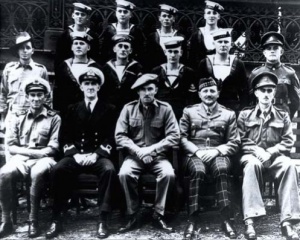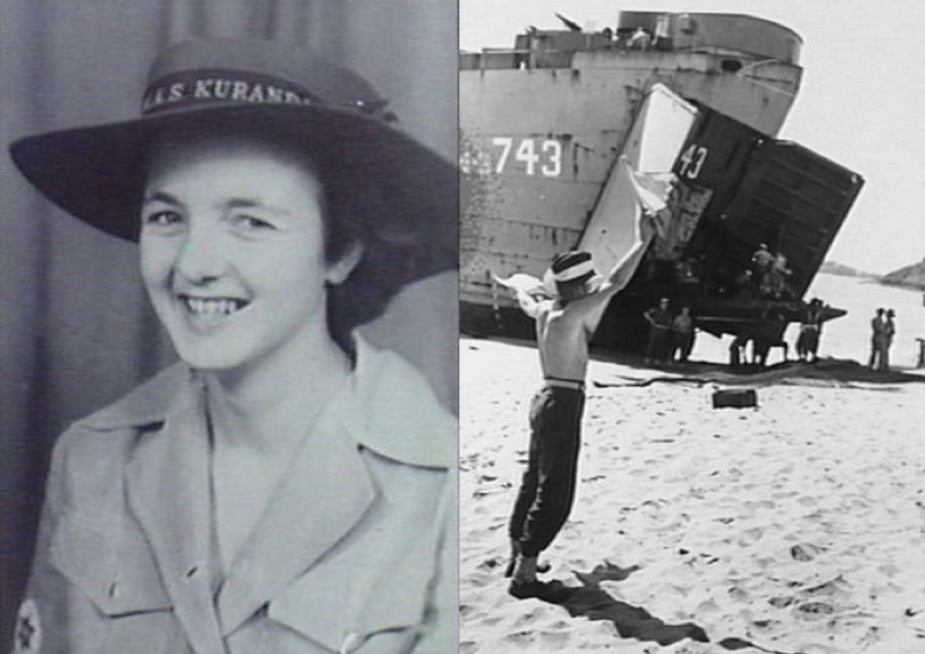HMAS Kuranda
HMAS Kuranda (from the Yindinji word kuran) was a shore-based naval depot in Cairns, Queensland.
For the holidaymakers visiting Cairns today, little remains to attest to the Royal Australian Navy’s (RAN) wartime presence. In the critical days of 1942–43, however, amid the Pacific campaign and fears of a Japanese assault on the Australian mainland, the city and its port were a hub of activity.
As the Japanese moved steadily down the Malay Peninsula in January 1942, the local government urged residents to leave Cairns. In the coming weeks, half of Cairns’ 15,000 population evacuated, schools closed, and air raid drills were a common occurrence.[1] In June 1942, Cairns became the amphibious training site for two US Army divisions and an Australian Army division destined for the north coast of New Guinea. RAN personnel crewed and provided maintenance for the escort vessels assigned to the Australian division. Trinity Beach and Trinity Wharf were the centre of activity, and extensions to the wharf were made in 1942 and again in 1943 to accommodate the influx of shipping and the accompanying repair, refuelling, and victualling activities.[2]
Lieutenant Commander Norman S Pixley, MBE, VD, RANR, was initially appointed Naval Officer in Charge (NOIC). However, as the volume of activities in Cairns increased, it became apparent that the responsibilities of the NOIC were in line with the appointment of an officer of Captain’s rank. On 4 March 1943, the Commanding Officer of HMAS Platypus, Acting Captain Ernest Clifford Rhodes, RAN, was duly appointed NOIC Cairns. Operating from Platypus, which was permanently moored in Cairns as a floating headquarters, Rhodes oversaw the administration of up to four destroyers, two sloops, 13 minesweepers, and four survey vessels.[3] Work also commenced on a new base headquarters, an armament and naval stores depot, and an oil fuel installation with a capacity of 15,000 tonnes furnace oil and 10,000 tonnes distillate.[4]
On 18 April 1944, Commander Henry Hersee Palmer, RAN, took on the role of NOIC Cairns. The following month, Platypus departed Cairns for a major refit and to serve in New Guinea as a Repair and Maintenance Vessel. With the new base headquarters complete, HMAS Kuranda commissioned into service on 8 May 1944. The name Kuranda was taken from the village in the mountainous rainfall 25 kilometres from Cairns. The duties of the personnel at Kuranda included the laying of mines in the water out from Cairns harbour and the refuelling, victualling, and maintenance of minor naval craft.[5]
WRANS in Cairns
Members of the Women’s Royal Australian Naval Service (WRANS) were posted to Cairns, commencing service from March 1943. The first four WRANS to arrive in Cairns were teleprinter operators from HMAS Harman, Betty Goodman, Bette Cleary, Daphne Samms and Betty Davis. These four were soon joined by two writers and four coders. At the peak of its activity, there were more than 60 WRANS posted to Kuranda. As more WRANS arrived, accommodation became a challenge, with local WRANS living in their own homes and those drafted from further afield stayed at Homeleigh boarding house-come-Wrannery. A building called Auchenflower was also taken over for the WRANS officer’s mess. In addition to the hard work expected of every WRAN, the Kuranda WRANS filled their time with trips to the mountains encircling Cairns and bathing and picnicking at the beach.[6]

MV Krait and Operation JAYWICK
Cairns was also the training site for the famous Z Special Unit (Z Force) crew of MV Krait and Operation JAYWICK. Krait (ex-Kofuku Maru) was an unassuming Japanese motor sampan seized by British authorities in Singapore in the wake of Japan’s entrance into the war.
Under direction of Services Recognisance Department, Krait was assigned to JAYWICK. Krait’s Z Force crew of four soldiers and 10 sailors were tasked with disguising themselves as Malay fisherman so as to infiltrate enemy territory and attack Japanese shipping. In the former home of the First Lord Mayor of Cairns, known as the House on the Hill, the crew planned and prepare for their covert mission. In Cairns harbour they undertook practice raids on shipping and catalinas and learnt how to attach bombs to the hulls of ships and the bottom of aircraft. Krait departed Exmouth in Western Australia on 2 September 1943, returning five weeks later after one of the most successful clandestine raids in Australian history.[7]
The short life of HMAS Kuranda
Within six months of commissioning, Kuranda’s future was under question. As the fate of the war moved ever closer to an Allied victory, the volume of ships using Kuranda and HMAS Magnetic in Townsville decreased significantly. In November 1944, the Deputy Chief of Naval Staff was forced to admit that it “seemed to me to be illogical that we should maintain the two ports of Cairns and Townsville, within 150 miles of one each other, each carrying out broadly the same function”.[8] It was accordingly proposed that activities be condensed and only one base used. Magnetic, with its Wireless Station and superior slipping facilities, was the base selected to remain fully operational.
The Kuranda WRANS took part in the base decommissioning, a rather sad occasion for many of these women as they said goodbye to their wartime home. The Argus reported that:
It was with particular regret that they took down their pennants from the walls of the recreation room pennants they had won for a combined servicewomen’s sports meeting and for table tennis. The naval crest was also taken down from over the door, and the flag was lowered.[9]
On 2 January 1945, just eight months after being commissioned, Kuranda was paid off and its accounts transferred to Magnetic.[10] Cairns remained a minor port until the end of the war, providing fuel to merchant shipping and RAN ships forced to enter the port in poor weather or in need of emergency fuel.[11]
Works cited
- ↑ ‘Cairns During World War II - Stories and Photos’, Cairns Regional Council: https://www.cairns.qld.gov.au/region/heritage/ww2-history.
- ↑ ‘US Bases - Cairns’, Sea Power Centre - Australia (SPC-A) 146AI; Cairns Trinity Wharf Warehouses No 2 and No 3, Queensland WWII Historic Places, https://www.ww2places.qld.gov.au/place?id=403.
- ↑ ‘Cairns Naval Base’, 146AI SPC-A.
- ↑ Naval Bases - Australia, SPC-A; ‘RAN Hirings’, 146AI SPC-A.
- ↑ ‘Cairns Naval Base’, 146AI SPC-A.
- ↑ M Curtis-Otter, The Women’s Royal Australian Naval Service (Sydney: The Naval Historical Society of Australia, 1975), 37-8; Shirley Fenton Huie, Ships Bells: The Story of the Women’s Royal Australian Naval Service in Peace and War, 1941-85 (Sydney: The Watermark Press, 2000), 85-8.
- ↑ ‘Cairns During World War II - Stories and Photos’, Cairns Regional Council, https://www.cairns.qld.gov.au/region/heritage/ww2-history; ‘Krait and Operation JAYWICK’, Sea Power Centre - Australia, https://seapower.navy.gov.au/history/feature-histories/krait-and-operation-jaywick.
- ↑ Deputy Chief of Naval Staff, Minute Paper, ‘Cairns and Townsville’, 23 November 1944, 146AI SPC-A.
- ↑ WRANS See Death of a Port, The Argus, 20 March 1945, 7.
- ↑ ‘Cairns Naval Base’, 146AI SPC-A.
- ↑ ‘Base Staff Cairns - Organisation’, NOIC Cairns to Secretary of the Naval Board, 18 January 1945, 146AI SPC-A.




